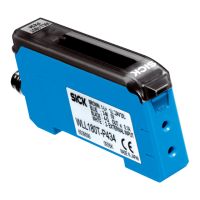WLL180T Photoelectric sensors for fiber-optic cables
2010-08-02 SICK 9
Subject to change without notice
The switching point of the object is learned, and detected, within a
window. This window can be manually extended for the lower (far)
and higher (near) switching threshold, respectively.
Adjust diffuse type fiber to the background without and with object.
2. Operating mode
Teach-in active
Teach-in
4. Zone Teach-in is shown on
the display
5. Press Teach-in key
Adjusts the zone with ± 10 % according to the light received.
1.4 Zone Teach-in
Typical applications:
Ideal for mark detection, e. g. detecting no. 2 (see diagram above)
with variable window. Or “foreground suppression” and “back-
ground suppression” simultaneously.
3. In the basic menu, select
required mode by pressing
the arrow keys
–
+
1. Press Teach-in key for 2 s
Optionally, the switching thresholds for close and
far ranges can be readjusted, via the arrow keys.
9. Press arrow key in
main display
10. Range (FAr) or (nEAr)
can be selected with arrow keys
11. Select far (FAr) or near (nEAr) range
by pressing the mode key
12. The value of the received light (red display) then appears, and
the threshold value (green display) flashes for about 5 seconds.
During this time, the threshold value for the selected range can
be set via the arrow keys.
6. Teach-in successful, set switch-
ing threshold blinks 3x and the
display returns to the main dis-
play
–
+
Threshold
Zone
Near
Far
Upper limit
Lower limit
10%
10%
Zone
10%
10%
t
4096
Q = ON/OFF
0
Gain
WLL180T – Zone Detection
2000
~2200
~1800
}
}
Extendable (near zone)
Extendable (far zone)
Threshold level
Min: + 10 %
Min: - 10 %
1
2
3
In case of faulty input during Teach-in,
the following messages are shown:
Sensing level is too low
Sensing level is saturated
Difference of sensing level between
two points is too small

